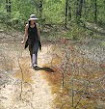"As mankind continued to chip his chert for stone warfare at the end of the Stone Age, he became very interested in the nut as food. It is thought that the movement of a nut called hazel or Corylus across the world was due almost entirely to mankind's fondess for its flavour. Indeed in North America, the mesolithic practice of the grand savannah design came into being primarily as a nut pasture to amplify game. This was a design centered around the open solar exposure of a nut-bearing canopy, whose wild grass pasture was flash-fired in April and November. This ashing of the soil produced fertilizer, pest management and increased herd capacity all rolled into one. The real gold came later on in the fall as crops of nuts. These were called pekan, or nut, throughout the length and breadth of the continent by an aboriginal culture that knew what it was doing and why it was doing it."Diana Beresford-Kroeger, Arboretum Borealis, University of Michigan Press, Ann Arbor. 2010. P43.
24 November 2010
Speaking of First Nations Arboriculture...
Subscribe to:
Post Comments (Atom)

1 comment:
Thanks for sharing these bits of information about the impact of aboriginals on our forests. It's been fascinating!
Post a Comment